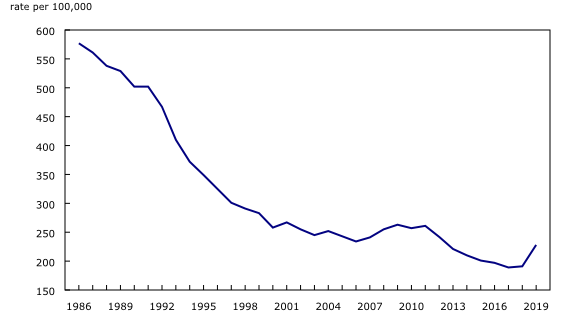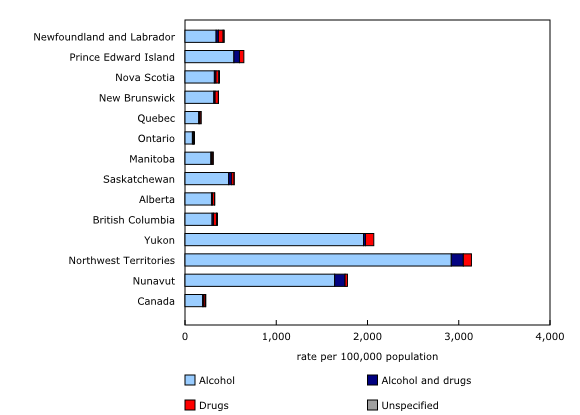Impaired driving in Canada, 2019
Archived Content
Information identified as archived is provided for reference, research or recordkeeping purposes. It is not subject to the Government of Canada Web Standards and has not been altered or updated since it was archived. Please "contact us" to request a format other than those available.
Released: 2021-07-15
In 2019, the rate of police-reported incidents of impaired driving was up 19% from the rate recorded in 2018. More specifically, the rate of alcohol-impaired driving increased by 15%, while the rate of drug-impaired driving increased by 43% in this first year since the legalization of cannabis.
In the wake of the legalization of cannabis, new legislative measures on impaired driving―whether by alcohol, cannabis or other drugs―were implemented in 2018. Police were granted new powers to screen for alcohol and drugs, and new criminal offence categories were created. This increase in police capabilities may have contributed to the rise in the rate of police-reported impaired driving in 2019.
In March, a Daily article entitled "Alcohol and cannabis use during the pandemic: Canadian Perspectives Survey Series 6" revealed that alcohol consumption, on the whole, had not increased during the COVID-19 pandemic. However, the study noted a slight increase in cannabis use. In addition, the increase in retail alcohol sales during the pandemic suggests that Canadians have been more likely to consume at home; fewer opportunities for socializing may have had a downward impact on consumption outside the home, particularly in bars and restaurants. Data from the current study were collected before the pandemic, but other data collected from a sample of police services point to a decline in impaired driving during the pandemic.
Today, Statistics Canada presents a detailed analysis of police-reported incidents of impaired driving and their progress in criminal courts in the Juristat article "Impaired driving in Canada, 2019."
Marked increase in police-reported drug-impaired driving
In 2019, police services in Canada reported 85,673 incidents of impaired driving, for a rate of 228 incidents per 100,000 population. This rate is 19% higher than the previous year. The rate of alcohol-impaired driving incidents, including impairment by both alcohol and drugs, increased by 15%, while the rate of drug-impaired driving rose 43%.
Despite a marked increase in drug-impaired driving, these incidents represented less than 1/10 (8%) of police-reported incidents of impaired driving in 2019. This proportion has been steadily increasing since 2008, when Statistics Canada started distinguishing between impaired driving as a result of alcohol or drug impairment.
The police-reported rate of impaired driving in 2019 is the highest in nearly 10 years. Despite this increase, the rate is less than half of what it was when comparable data began being collected in 1986, when it was 577 incidents per 100,000 population (Chart 1).
Prince Edward Island has the highest rate of police-reported impaired driving among the provinces
Among the provinces, Prince Edward Island had the highest rate of impaired driving. At 645 incidents per 100,000 population, this rate was nearly three times higher than the national average (228 incidents per 100,000 population). Saskatchewan followed, with 539 impaired driving incidents per 100,000 population. However, these rates remain lower than those in the territories; in the Northwest Territories, the rate reached 3,139 incidents per 100,000 population.
Ontario (104 incidents per 100,000 population), Quebec (176) and Manitoba (310) were the provinces with the lowest rates of impaired driving.
Drug-impaired driving incidents were less likely to be cleared by charge
In 2019, more than half (56%) of impaired driving incidents were cleared by charge, 10% were cleared without charge, and one-third (33%) were not cleared (that is, not resolved). Incidents of drug-impaired driving were slightly less likely than incidents involving alcohol to be cleared by charge (49% compared with 57%). They also took more time to clear: 37% of drug-impaired driving incidents that were cleared by police required more than a month to be cleared, compared with 17% of alcohol-related incidents.
Slightly more than three-quarters (77%) of drivers accused of impaired driving in 2019 were men. Young people aged 20 to 34 were also overrepresented: they accounted for about one-quarter of driver's licence holders, but 44% of impaired drivers.
Cases of impaired driving take more time to be processed and are less likely to result in a guilty finding
Cases of drug-impaired driving take more time in criminal court than alcohol-related cases. In 2018/2019, the median time required to complete a drug-impaired driving case was 211 days, compared with 115 days for cases of alcohol-impaired driving.
Cases of drug-impaired driving were also less likely to result in a guilty finding than cases of alcohol-impaired driving: 70% resulted in a guilty finding, compared with 82% of alcohol-related cases.
Note to readers
The data presented in this article are derived mainly from two data sources: the Uniform Crime Reporting Survey (UCR) and the Integrated Criminal Court Survey (ICCS). Data from the UCR represent impaired driving incidents, as defined in the Criminal Code, which the police became aware of. To distinguish impaired driving incidents based on impairment by alcohol, drugs or a combination of alcohol and drugs, ICCS data were linked with UCR data.
Police-reported statistics may be affected by differences in the way police services deal with offences. In 2018, Statistics Canada, in collaboration with police services, updated the definition of "founded criminal incidents" to reflect a more victim-centred approach to recording crimes. The purpose of the changes to these definitions was to begin including incidents where there is no credible evidence that the incident did not take place, as well as those based on reports by third parties (e.g., a road user reporting a potentially impaired driver), in "founded criminal incidents." Given these new definitions, the police may classify more cases as "founded" and thus contribute to an increase in the number of police-reported incidents of impaired driving.
Products
The Juristat article "Impaired driving in Canada, 2019" (85-002-X), is now available.
Contact information
For more information, or to enquire about the concepts, methods or data quality of this release, contact us (toll-free 1-800-263-1136; 514-283-8300; STATCAN.infostats-infostats.STATCAN@canada.ca) or Media Relations (613-951-4636; STATCAN.mediahotline-ligneinfomedias.STATCAN@canada.ca).
- Date modified:



